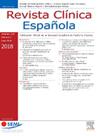托伐坦与尿素在多动症引起的低血症患者中的疗效比较研究
IF 1.7
4区 医学
Q2 MEDICINE, GENERAL & INTERNAL
引用次数: 0
摘要
背景和目的低钠血症常见于老年和住院患者,通常由抗利尿激素分泌不当综合征(SIADH)引起。本研究评价托伐普坦和尿素在低钠血症和SIADH患者中的疗效和安全性。材料与方法对198例SIADH合并低钠血症(Na+ <;(2015年1月至2022年5月)在Pontevedra Universitario Complejo Hospitalario de Pontevedra。其中86例接受托伐普坦治疗(平均剂量为7.5 mg), 112例接受尿素治疗(平均剂量为15 g)。主要结局是钠水平正常化(Na+≥135 mmol/L)。结果托伐普坦组治疗结束时钠浓度高于尿素组(ME = 136, IQR = 135 ~ 137 vs ME = 134, IQR = 132 ~ 137;p & lt;0.001)。托伐普坦使钠恢复正常所需时间(4±3.4天)短于尿素(6±3.6天);p = 0.03)。使用托伐普坦后钠恢复正常的患者比例更高(83.72 vs 59.82%;p = 0.005)。托伐普坦有更多的不良反应,如口干、口渴和钠矫治过度,而尿素则引起吞咽困难、腹痛和腹泻。两组之间的死亡率没有显著差异。结论与尿素相比,伐他坦在钠水平正常化方面更有效、更快,但其不良反应比例更高,不需要停药。本文章由计算机程序翻译,如有差异,请以英文原文为准。
Estudio comparativo de la efectividad de tolvaptán frente a urea en pacientes con hiponatremia causada por SIADH
Background and objectives
Hyponatraemia is common in elderly and hospitalised patients, often caused by the syndrome of inappropriate antidiuretic hormone secretion (SIADH). This study evaluates the efficacy and safety of tolvaptan and urea in patients with hyponatraemia and SIADH.
Materials and methods
An observational cohort study was conducted on 198 patients with SIADH and hyponatraemia (Na+ < 135 mmol/L) at the Complejo Hospitalario Universitario de Pontevedra (January 2015-May 2022). Of these, 86 were treated with tolvaptan (average dose of 7.5 mg) and 112 with urea (average dose of 15 g). The primary outcome was the normalisation of sodium levels (Na+ ≥ 135 mmol/L).
Results
The tolvaptan group showed higher sodium concentrations at the end of therapy compared to the urea group (ME = 136, IQR = 135-137 vs. ME = 134, IQR = 132-137; p < 0.001). The time to normalise sodium was shorter with tolvaptan (4 ± 3.4 days) compared to urea (6 ± 3.6 days; p = 0.03). A higher percentage of patients achieved sodium normalisation with tolvaptan (83.72 vs. 59.82%; p = 0.005). Tolvaptan had more adverse effects, such as dry mouth, thirst, and sodium overcorrection, while urea caused dysgeusia, abdominal pain, and diarrhea. There were no significant differences in mortality between the groups.
Conclusions
Tolvaptan was more effective and quicker than urea in normalising sodium levels, though it showed a higher percentage of adverse effects, which did not require discontinuation of the drug.
求助全文
通过发布文献求助,成功后即可免费获取论文全文。
去求助
来源期刊

Revista clinica espanola
医学-医学:内科
CiteScore
4.40
自引率
6.90%
发文量
73
审稿时长
28 days
期刊介绍:
Revista Clínica Española published its first issue in 1940 and is the body of expression of the Spanish Society of Internal Medicine (SEMI).
The journal fully endorses the goals of updating knowledge and facilitating the acquisition of key developments in internal medicine applied to clinical practice. Revista Clínica Española is subject to a thorough double blind review of the received articles written in Spanish or English. Nine issues are published each year, including mostly originals, reviews and consensus documents.
 求助内容:
求助内容: 应助结果提醒方式:
应助结果提醒方式:


